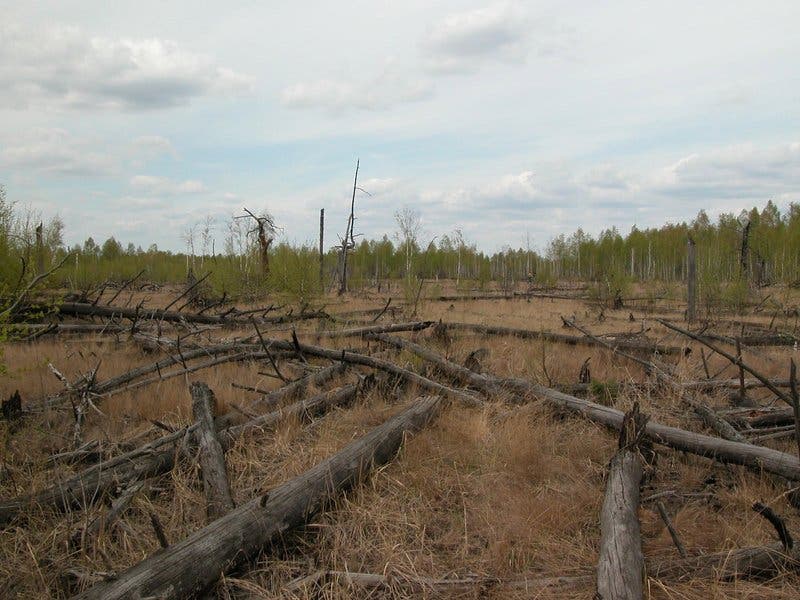
Some thirty years after Chernobyl’s nuclear plant meltdown that caused an international incident, scientists have yet to assess the full blown damage the radioactive disaster has caused. While the rest of the world has moved on, ever since the disaster the area surrounding the former nuclear plant has remained largely unchanged, even the plants and trees there seem to have stayed the same. Not like your usual backyard tree that flowers and withers with the seasons; in Chernobyl nature has altered its course and refuses to die easily.
Tim Mousseau, a professor of biology at the University of South Carolina and colleagues visiting the area found that trees, plants and leaves at the contaminated site don’t decay at nearly the same rate as plants elsewhere. Clearly, the ecosystem at Chernobyl was severely altered by the meltdown, but it was unclear until now what effects the radioactive leakage had on the vegetation’s natural cycle.
“We were stepping over all these dead trees on the ground that had been killed by the initial blast,” Mousseau said. “Years later, these tree trunks were in pretty good shape. If a tree had fallen in my backyard, it would be sawdust in 10 years or so.”
The radioactive forest
The researchers based most of their in the infamous Red Forest – a wooden region surrounding Chernobyl where threes turned a reddish-brown color before dying. Even after a few decades though, the fallen tree trunks have remained largely unchanged. Somehow the decay process has been altered and delayed, like a processed hamburger compared to fresh home-cooked food.
“Apart from a few ants, the dead tree trunks were largely unscathed when we first encountered them,” Mousseau, who is also co-director of the Chernobyl and Fukushima Research Initiatives at the University of South Carolina, told Smithsonian.
To unravel this startling puzzle, the researchers collected hundreds of samples of leaf litter from forest floors that were not contaminated by radiation and stuffed the leaves into bags lined with panty hose to keep out insects. Each of the bag was then carefully distributed around Chernobyl, as well as uncontaminated site for control purposes.
The results are no less amazing: the samples that were placed in highly contaminated areas decayed up to 40% harder than samples that were placed in uncontaminated sites. Decomposition varied proportionately according to the level of contamination for each area.
It’s because fewer bacteria and microorganisms can survive the radiation
Many plants that die along with the leaves that fall from trees in the autumn will all rot down and become part of the forest floor. They are decomposed by fungi, bacteria and many different species of invertebrate. Fungi unseen from the surface can spread through the entire forest floor, living on the dead leaves and twigs that have fallen from the trees above. They can extract many of the useful substances for their own benefit, helping to rot down the dead plant material in the process. Many of the chemicals which remain after decomposition get dissolved in the soil and become nutrients for living plants including newly germinated seedlings. These nutrients can be taken up by the plant’s roots in the soil and are used to help make new leaves, twigs, branches, roots, flowers and seeds.
[READ] Chernobyl fungus feeds on nuclear radiation
Clearly, at Chernobyl the microorganisms aren’t doing their job properly because, at their own hand, they’ve been killed off by radiation too. This is in line with previous research which found that cancer patients who had undergone radiation therapy had a lower population of helpful bacteria in the intestines, leading to health issues.
Chernobyl and all living things around it are basically screwed and will stay that way for a long, long time. There’s a more immediate peril lurking, according to the researchers. Because the forest floor is decaying at such a slow rate, there is a growing concern that there could be a catastrophic fire in the coming years. It’s not only that the fire would have a lot of material to burn, it’s all the nature of the wood and other organic compounds that might get set ablaze – everything’s contaminated!
“That would end up moving radiocesium and other contaminants via smoke into populated areas,” Mousseau said.
“This litter accumulation that we measured, which is likely a direct consequence of reduced microbial decomposing activity, is like kindling,” Mousseau added. “It’s dry, light and burns quite readily. It adds to the fuel, as well as makes it more likely that catastrophically sized forest fires might start.”






